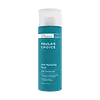Paula's Choice Skin Balancing Pore-Reducing Toner Versus Paula's Choice Skin Balancing Oil-Reducing Cleanser
What's inside
What's inside
 Key Ingredients
Key Ingredients

No key ingredients
 Benefits
Benefits

 Concerns
Concerns

No concerns
 Ingredients Side-by-side
Ingredients Side-by-side

Water
Skin ConditioningGlycerin
HumectantButylene Glycol
HumectantNiacinamide
SmoothingPolysorbate 20
EmulsifyingAdenosine
Skin ConditioningAnthemis Nobilis Flower Extract
MaskingArctium Lappa Seed Oil
EmollientHydrolyzed Jojoba Esters
Skin ConditioningSodium PCA
HumectantPanthenol
Skin ConditioningSodium Hyaluronate
HumectantCeramide NP
Skin ConditioningCeramide AP
Skin ConditioningCeramide EOP
Skin ConditioningPhytosphingosine
Skin ConditioningCholesterol
EmollientTetrahexyldecyl Ascorbate
AntioxidantOleth-10
EmulsifyingSodium Lauroyl Lactylate
EmulsifyingCaprylyl Glycol
EmollientHexylene Glycol
EmulsifyingSodium Citrate
BufferingXanthan Gum
EmulsifyingTrisodium EDTA
Phenoxyethanol
PreservativeWater, Glycerin, Butylene Glycol, Niacinamide, Polysorbate 20, Adenosine, Anthemis Nobilis Flower Extract, Arctium Lappa Seed Oil, Hydrolyzed Jojoba Esters, Sodium PCA, Panthenol, Sodium Hyaluronate, Ceramide NP, Ceramide AP, Ceramide EOP, Phytosphingosine, Cholesterol, Tetrahexyldecyl Ascorbate, Oleth-10, Sodium Lauroyl Lactylate, Caprylyl Glycol, Hexylene Glycol, Sodium Citrate, Xanthan Gum, Trisodium EDTA, Phenoxyethanol
Water
Skin ConditioningSodium Cocoyl Isethionate
CleansingSodium Lauroamphoacetate
CleansingStearic Acid
CleansingGlycerin
HumectantGlycol Distearate
EmollientHelianthus Annuus Seed Oil
EmollientAcrylates Copolymer
Cetearyl Alcohol
EmollientAloe Barbadensis Leaf Extract
EmollientSodium Chloride
MaskingSodium Hydroxide
BufferingXanthan Gum
EmulsifyingCaprylyl Glycol
EmollientHexylene Glycol
EmulsifyingDisodium EDTA
Phenoxyethanol
PreservativeWater, Sodium Cocoyl Isethionate, Sodium Lauroamphoacetate, Stearic Acid, Glycerin, Glycol Distearate, Helianthus Annuus Seed Oil, Acrylates Copolymer, Cetearyl Alcohol, Aloe Barbadensis Leaf Extract, Sodium Chloride, Sodium Hydroxide, Xanthan Gum, Caprylyl Glycol, Hexylene Glycol, Disodium EDTA, Phenoxyethanol
 Reviews
Reviews

Ingredients Explained
These ingredients are found in both products.
Ingredients higher up in an ingredient list are typically present in a larger amount.
Caprylyl Glycol is a humectant and emollient, meaning it attracts and preserves moisture.
It is a common ingredient in many products, especially those designed to hydrate skin. The primary benefits are retaining moisture, skin softening, and promoting a healthy skin barrier.
Though Caprylyl Glycol is an alcohol derived from fatty acids, it is not the kind that can dry out skin.
This ingredient is also used as a preservative to extend the life of products. It has slight antimicrobial properties.
Learn more about Caprylyl GlycolGlycerin is already naturally found in your skin. It helps moisturize and protect your skin.
A study from 2016 found glycerin to be more effective as a humectant than AHAs and hyaluronic acid.
As a humectant, it helps the skin stay hydrated by pulling moisture to your skin. The low molecular weight of glycerin allows it to pull moisture into the deeper layers of your skin.
Hydrated skin improves your skin barrier; Your skin barrier helps protect against irritants and bacteria.
Glycerin has also been found to have antimicrobial and antiviral properties. Due to these properties, glycerin is often used in wound and burn treatments.
In cosmetics, glycerin is usually derived from plants such as soybean or palm. However, it can also be sourced from animals, such as tallow or animal fat.
This ingredient is organic, colorless, odorless, and non-toxic.
Glycerin is the name for this ingredient in American English. British English uses Glycerol/Glycerine.
Learn more about GlycerinHexylene Glycol is a surfactant. Glycols are a class of alcohols. Hexylene Glycol is a surfactant and emulsifier.
As a surfactant, Hexylene Glycol helps gather dirt and oil on your skin to be washed away.
As an emulsifier, Hexylene Glycol helps keep water and oil together. This prevents them from separating in a product. Hexylene Glycol also thins out the texture of a product by lessening viscosity.
Hexylene Glycol has a small molecular weight.
Learn more about Hexylene GlycolPhenoxyethanol is a preservative that has germicide, antimicrobial, and aromatic properties. Studies show that phenoxyethanol can prevent microbial growth. By itself, it has a scent that is similar to that of a rose.
It's often used in formulations along with Caprylyl Glycol to preserve the shelf life of products.
Water. It's the most common cosmetic ingredient of all. You'll usually see it at the top of ingredient lists, meaning that it makes up the largest part of the product.
So why is it so popular? Water most often acts as a solvent - this means that it helps dissolve other ingredients into the formulation.
You'll also recognize water as that liquid we all need to stay alive. If you see this, drink a glass of water. Stay hydrated!
Learn more about WaterXanthan gum is used as a stabilizer and thickener within cosmetic products. It helps give products a sticky, thick feeling - preventing them from being too runny.
On the technical side of things, xanthan gum is a polysaccharide - a combination consisting of multiple sugar molecules bonded together.
Xanthan gum is a pretty common and great ingredient. It is a natural, non-toxic, non-irritating ingredient that is also commonly used in food products.
Learn more about Xanthan Gum